Tips for night driving

The somewhat scorching afternoon weather and congested traffic make some of us prefer to drive at night.
However, driving at night is not the same as driving during the day.
There are many factors that can limit our visibility and increase the risk of accidents.
If you intend to drive at night, here are some tips to keep in mind:
1. Ensure your body is well-rested
Lighting factors will help you focus more on what is coming from the front. As a result, the brain will become more tired, and the situation will worsen if you are not aware that you are actually experiencing microsleep.
What the author practices is to sleep early to get enough rest before embarking on a journey in the middle of the night.
2. Ensure the headlights are functioning properly
Most of the time, we rely on the headlights to determine the distance and objects ahead. If the lights are not in good condition or the beam position is too low, it can limit clear visibility.
High beam position can also endanger oncoming drivers due to excessive glare issues, especially with average modern cars using LED lights.
3. Ensure the front and side mirrors are clean from dirt
Clean front windshield provides a clearer field of vision, and are safer especially at night. If the front windshield is dirty or oily, this condition will scatter light, worsening the glare effect of headlights from the front.
Look for an old newspaper not in use to wipe these areas.
4. Avoid ambient lights that can disrupt driving
Modern cars are now equipped with ambient lighting systems akin to roadside “tomyam” stalls. Some offer beautiful lighting graphics, while others can disrupt driving at night.
If this happens, try adjusting the cabin ambient light brightness to a minimum level, or simply turn it off. No one wants to see the condition of your car’s “tomyam” stall from the outside anyway.
5. Drive at a controllable speed
One advantage of night driving is quieter road conditions, but it is not a license to exceed the speed limit. Driving more cautiously is the best way to ensure you have enough time to react to any unexpected situations such as animals crossing, cars skidding, or the end of the road having no proper lighting system. Remember the distance rule taught in driving school? Practice it.
Another common tip the author follows when driving at night is to have a mapping navigation app running at all times, especially when driving on unfamiliar routes, so you can estimate the road structure and know about road damage/incident reports uploaded by other users.
6. Avoid driving for extended periods
Driving at night will make your body more tired than usual. Therefore, it is advised to stop and rest every one or two hours to get fresh air, do some quick body stretching exercises, or have a hot cup of coffee to refresh your brain.
If you feel very tired, take a short nap, but make sure your car windows are not tightly closed to reduce the risk of carbon monoxide poisoning.
Someone who loves driving manual cars but prefers riding an automatic scooter. Maybe it's an age thing.









